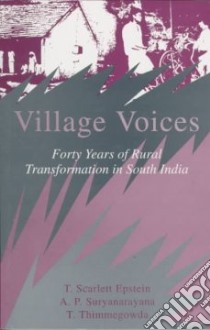Village Voices - 9780761992660
Un libro in lingua di Epstein T. Scarlett (EDT) Suryanarayana A. P. (EDT) Thimmegowda T. (EDT) edito da Sage Pubns, 1998
- € 40.70
- Il prezzo è variabile in funzione del cambio della valuta d’origine
This book sets out in detail, and in a very engaging manner, the thrills as well as the difficulties involved in living with and at the same time studying rural societies. A unique feature of this absorbing account is that it documents forty years of change (both positive and negative) in two villages of south India by the same team of researchers. T. Scarlett Epstein, an expatriate scholar, was assisted by A. P. Suryanarayana when she conducted her first field research in these villages between 1954 and 1956. These two researchers studied the villages for a second time in 1970 and Professor Epstein predicted the changes would occur by the turn of the century. In 1996-7, they were joined by T. Thimmegowda--an exceptional researcher from one of these villages--for this re-study and found that most that most of her prognostications were fairly accurate. Another unusual feature of this book is that not only does each co-author describe and analyze the changes from her or his perspective but, wherever feasible, they allow their village informants to speak for themselves. The appraisal of observed changes--educational, agricultural, economic, socio-political--is thus set against the different personalities and experiences of both the researchers and the informants and also their interactions. The aim in doing so is to make the reader aware of possible subjective influences on perceptions of socio-economic changes and to facilitate an evaluation of bias. The result is a rare insight into the process of and the problems associated with rural transformation which highlights the importance of culturally sensitive development strategies. The authors' primary objective is to re-introduce the human element in village studies, to promote a growing concern about rural development and to involve the reader in the lives of villagers. To this end they introduce the human element in village studies, to promote a growing concern about rural development and to involve the reader in the lives of the villagers. To this end they include a questionnaire designed to encourage a continued dialogue between readers and researchers. A documentary film with the same title which complements the book is also available through the authors. This unusual and absorbing book will be of interest to all those concerned with Third World development particularly voluntary organizations and public servants and also to those in the fields of rural development, social anthropology, sociology, and qualitative research.
Informazioni bibliografiche
- Titolo del Libro in lingua: Village Voices
- Sottotitolo: Forty Years of Rural Transformation in South India
- Lingua: English
- Autori : Epstein T. Scarlett (EDT) Suryanarayana A. P. (EDT) Thimmegowda T. (EDT)
- Editore: Sage Pubns
- Collana: Sage Pubns (Paperback)
- Data di Pubblicazione: 24 Novembre '98
- Genere: SOCIAL SCIENCE
- Argomenti : Rural development India Social change India Villages India
- Dimensioni mm: 222 x 139 x 12
- ISBN-10: 0761992669
- EAN-13: 9780761992660


